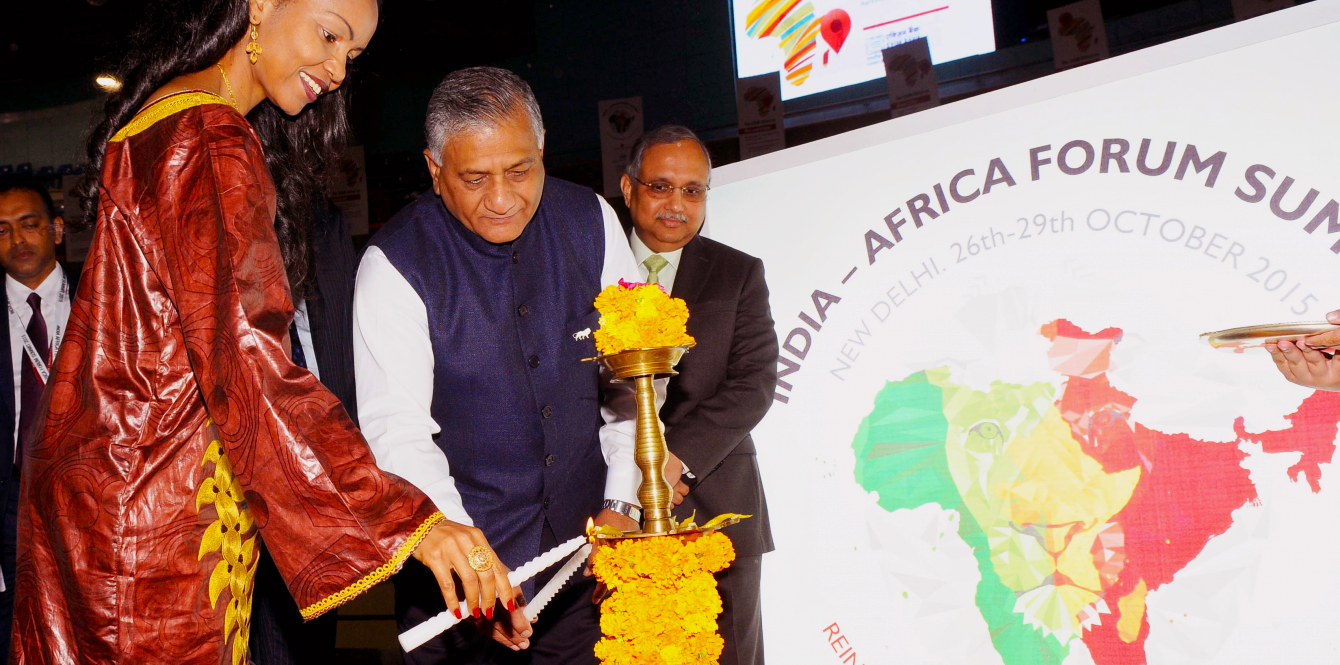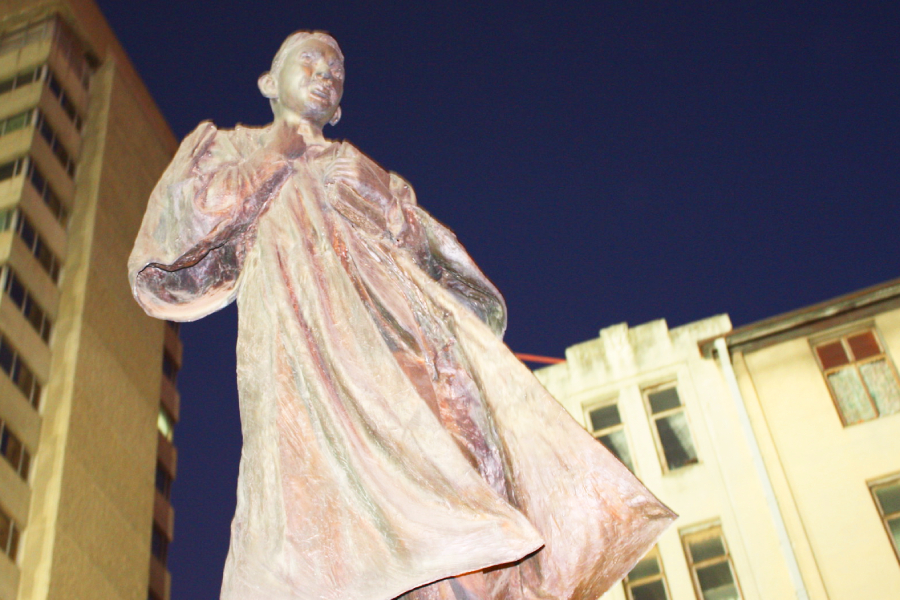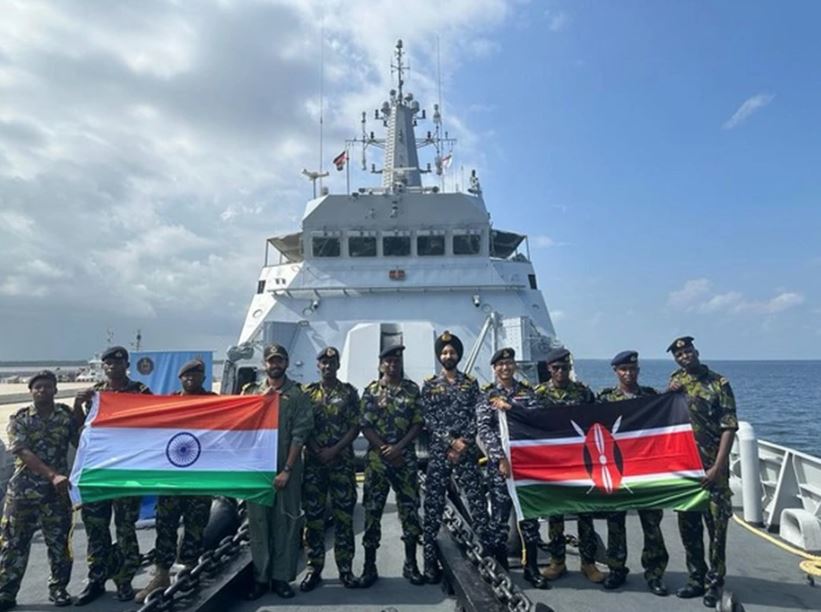
Indian Defense officials pose for a group photo with delegates from African countries during the India-Africa Army Chief’s Conclave in Pune in the western Indian state of Maharashtra. (Photo: Money Sharma / AFP)
India’s first prime minister, Jawaharlal Nehru, termed Africa as India’s “sister continent,” in recognition of the long ties of affinity. Since the 1960s, India’s prime ministers have visited Africa 76 times, a level of engagement unmatched by Africa’s other external partners. Between 2015 and 2022, New Delhi received over 100 African leaders, while each African country received an Indian cabinet minister. Indo-African ties cover culture, education, trade, technical cooperation, energy, agriculture, maritime security, peacekeeping, and professional military education.
India also builds capacity for good governance through institutions like the India International Institute of Democracy and Election Management, which has trained hundreds of African and Asian stakeholders. To better understand this important yet underlooked relationship, the Africa Center for Strategic Studies spoke to several Indian and African experts for their insights.
India’s Strategic Engagements in Africa
Thanks, in part, to heavy Indian lobbying, the African Union was included as a full member of the G-20 at the New Delhi Summit in September 2023. Calling Africa “India’s top priority,” Prime Minister Narendra Modi, said, “When we use the term ‘Global South,’ it is not just a diplomatic term. … In our shared history, we have together opposed colonialism and apartheid. It was on the soil of Africa that Mahatma Gandhi used powerful methods of non-violence and peaceful resistance. It is on this strong foundation of history that we are shaping our modern relations.”
The next triennial India-Africa Forum Summit is planned for 2024. In January 2023, 47 African countries attended the Voice of the Global South Summit. In June 2023, African and Indian government, private sector, and industry leaders converged in New Delhi for the 18th India-Africa Conclave hosted by the India Export Import (EXIM) Bank in partnership with India’s foreign and trade ministries.
India-Africa trade has grown 18 percent annually since 2003, reaching $103 billion in 2023. This makes India Africa’s third largest trading partner after the European Union and China.

African Union Commissioner for Trade and Industry Fatima Haram Acyl (left) and India Minister of State for External Affairs Vijay Kumar Singh (center) at the Third India-Africa Forum Summit in October in New Dehli, India. (Photo: India Ministry of State for External Affairs)
India is also the second largest lender in Africa, with strong public-private partnerships and safeguards protecting borrowers from debt distress. In fact, most Indian aid is channeled through the African Development Bank (ADB), which New Delhi joined in 1983. India’s total investments in Africa amount to $70 billion, a figure the powerful Confederation of Indian Industry aims to increase to $150 billion by 2030.
“India’s unique story in Africa gives texture to its strategic engagement,” notes Aly-Khan Satchu, a Kenyan Indian and leading entrepreneur and investor. “Indian-Africans occupy a fascinating space in Africa’s landscape,” explains Veda Vaidyanathan, an associate fellow at the Centre for Social and Economic Progress (CSEP) in New Delhi and Harvard University’s Asia Center. They are an essential part of Africa’s middle class and play a major role in education, health, industrialization, and trade as well as participate in politics and serve in the military.
Indian-Africans are an essential part of Africa’s middle class and play a major role in education, health, industrialization, and trade.
While first generation Indians are outsiders to these African landscapes, the second, third generation Indian origin Africans are either familiar foreigners or not considered foreigners at all,” Vaidyanathan adds. “When I interview Kenyan Indians who have been in the country for generations, for example, they consider me ‘the other,’ a common feature of Indo-African attitudes. “They are insiders, weaved into the tapestry of their adopted countries.” Shobana Shankar, Professor at Stony Brook University, highlights the nuanced and historically complex African-Indian relationship that is dynamic, calling this an “emotional infrastructure” with its ups and downs that help mitigate tensions and maintain ties.”
Since independence, India believed it was destined to be a Great Power, meaning a self-reliant and economically and militarily powerful India with global respect and influence. These ambitions remain anchored in Africa. Abhishek Mishra, an associate fellow at the Manohar Parrikar Institute for Defence Studies and Analyses says that India’s global ambitions rest on South-South cooperation, which hinges on an “ascendant India and a resurgent Africa.” Hence, the thrust of India’s Africa policy is to “develop together as equals.” These are fleshed out in the “Kampala Principles,” 10 core tenets articulated by Prime Minister Modi during his address to Uganda’s Parliament in July 2018. The first two state the following:
“Africa will be at the top of our priorities. We will continue to intensify and deepen our engagement with Africa. As we have shown, it will be sustained and regular.
“Our development partnership will be guided by your [African] priorities. We will build as much local capacity and create as many local opportunities as possible. It will be on terms that are comfortable to you, that will liberate your potential and not constrain your future.”
These overarching principles include India’s other medium-term interests:
- Secure African support in India’s bid for a permanent membership on the UN Security Council
- Work with African countries to restructure global financial and multilateral institutions to prioritize the Global South
- Partner with African countries to suppress terrorism and ensure freedom of movement in the Indian Ocean
- Secure India’s resource and energy security
Where and how is India most active in Africa?
Abhishek Mishra observes that India traditionally focused on East and Southern Africa due to maritime proximity across the Indian Ocean and the large Indian diaspora. Over time, India expanded its engagements to over 44 countries thanks to the Ministry of External Affairs’ Indian Technical and Economic Cooperation (ITEC), which, since 1964, has devoted more than a third of its accounts to African countries in four areas: capacity building, project assistance, scholarships, and institution-building. It has trained over 200,000 civilian and defense professionals from 160 countries—mostly in Africa and Asia. India’s EXIM Bank has devoted 50 percent of its international financing, technical assistance, and trade promotion schemes to Africa. Africa’s largest digital project, the Pan African e-Network, is connecting Africa’s 54 countries to India and one another to share expertise in telecoms, medicine, health, resource mapping, and e-governance.
India has consistently been perceived as a trusted ally in Africa.
The prioritization of Africa within India’s investments is one of the reasons why India has consistently been perceived as a trusted ally in Africa. India enjoys observer status in the Common Market for Eastern and Southern Africa (COMESA), Southern African Development Community (SADC), and the Economic Community of West African States (ECOWAS).
In what areas does India feel it has unique advantages, and where can it add value to Africa?
India won independence from Britain in 1947 and was active in Africa’s independence movements. Besides Mahatma Gandhi, its early leaders (and prime ministers) Jawaharlal Nehru, his successor and daughter, Indira Gandhi, and grandson, Rajiv Gandhi, received dozens of decorations across Africa for their work on African liberation. Africa retains support across the political spectrum in India today.

A statue of Mahatma Gandhi looking over Gandhi Square in Johannesburg, South Africa. (Photo: South African tourism)
Most of Africa’s 3-million-strong Indian population descended from Indian indentured workers brought to Africa by the British during the early 18th century. Long before that, however, African communities were taken to India through the Arab slave trade. Their descendants—one of India’s minority populations—are called Sidhis.
“One thing we hear from African colleagues is that India does not act or speak like a donor,” says Veda Vaidyanathan. “It focusses on creating space to work together as equals, enabling the African side to exert agency and leadership, while India facilitates.” Professor Harsh Pant, a vice president at the Observer Research Foundation, in New Delhi, agrees. “India makes the following argument: we want to be part of your developmental journey, but we do not want this to be a donor-recipient relationship. We want this to be a relationship between two partners and to build greater capacity and resilience across African countries.”
The inclusion of African and Indian private sectors and professional associations in official India-Africa platforms enhances citizen agency. These groups are not engaged on the sidelines but participate in all deliberations in mechanisms like the India-Africa Forum Summit and the India-Africa Conclave.
India also leverages its unique access to African grassroots communities. An illustration of this is the Solar Mamas Project, a people-to-people venture in Rajasthan, India, created by Barefoot College in Tiloniya, so-named to reflect its grassroots focus. Veda Vaidyanathan explains: “This College equips women from impoverished communities in India and faraway African towns as solar engineers. After training together for 6 months, they go back to electrify their villages, earning them the title of ‘Solar Mamas.’”
“We do not want this to be a donor-recipient relationship. We want this to be a relationship between two partners.”
Recognizing this project’s game-changing potential to reduce dependence on fossil fuels, the Indian government helped extend it to 36 African countries. This dovetails with the objectives of India’s International Solar Alliance to assist 733 million people who live without power—the vast majority from Africa—to switch to renewable energy.
India also sponsors a robust pipeline of African students in India, a practice built in Nehru’s time and sustained throughout. Indian teachers and university faculty were also a critical part of the diaspora who came after the commercial Indian settlers in East and Southern Africa. In Senegal, the first president, Leopold Senghor, established a university exchange between his country and India for Indo-African studies, supported by Prime Minister Indira Gandhi.
The unique place of Indians in Africa creates a strong foundation for the larger relationship. Mahatma Gandhi spent 21 years in South Africa where he invented his principles of civil disobedience. The long list of prominent anti-apartheid icons of Indian heritage in South Africa includes his granddaughter, Ela Gandhi, and Fatima Meer, Ahmed Kathrada, Amina Cachalia, and Frene Ginwala. Prominent Indian-Africans in Africa’s democratization movements include: Anirut Jugnath and Navinchandra Ramgoolam (Mauritius); Nandini Patel (Malawi); Manilal Chandaria, Pio Gama Pinto, Fitzval Remedios Santana de Souza, and Pheroze Nowrojee (Kenya); Rajini Kanabar, JK Chande, and Issa Shivji (Tanzania); Wavel Ramkalawan (Seychelles); Ahmed Moosa Ebrahim (Zimbabwe); and Yash Tandon and Mahmood Mamdani (Uganda).
What are India’s defense and security cooperation priorities?
Abhishek Mishra notes that defense and security have emerged as a key pillar of India-Africa relations. This was underscored in March 2023, when the two sides convened the first ever India-Africa Army-Chiefs Conclave, alongside the second edition of the Africa-India Field Training Exercise (AFINDEX), held over 10 days in Pune, India. The two sides also conduct an annual India-Africa Defence Dialogue (IADD) that coincides with India’s Defence Expo.
India’s October 2022 “Gandhinagar Declaration” calls for more professional military education (PME) training slots for African countries under ITEC. Additionally, India and Africa engage in “specialized training and joint research in new areas like artificial intelligence, cyber security, munition systems, maritime surveillance, unmanned vehicles, space, and undersea scanning technologies,” explains Mishra.
India focusses most of its security assistance on building partner self-sufficiency.
African navies have participated in all 47 editions of India’s Maritime Partnership Exercise (MPX) in the Western Indian Ocean. Among its key outcomes is a Memorandum of Understanding (MOU) with Tanzania and Kenya on shipbuilding and port development. “We have also invited African officers to attend various Indian institutions like our Information Fusion Center (IFC-IOR) and instituted an India-Africa Security Fellowship hosted by the Manohar Parrikar Institute for Defence Studies and Analyses,” Mishra adds. “We recently hosted fellows from Kenya and Tanzania and will soon be inviting Nigerian officers.”
In line with its policy of “developing together as equals,” India focusses most of its security assistance on building partner self-sufficiency. This has led to the deployment of Indian technicians to strengthen African capacity to repair and maintain equipment, dock facilities, boats, tanks, guns, and aircraft. India also supplies hardware like offshore patrol craft, combat helicopters, interceptor boats, and armored vehicles.
What more do Africans wish to see and what is the future of Indo-African relations?
Sanusha Naidu, a third-generation South African–Indian and Senior Associate at South Africa’s Institute for Global Dialogue contends that, “The African Union should integrate key initiatives like the African Continental Free Trade Area and New Partnership for African Development into the larger Africa-India partnership. There is appetite on the Indian side for this type of partner agency and leadership.” Aly-Khan Satchu calls for a closer “triangulation” on all sides. “Indian diasporas have an embedded inclination to reach out to their home governments and connect them to the Indian government and private sector. However, this is not being fully leveraged, and it is only recently that Indian and African colleagues moved on this with greater intentionality.”
“Indian diasporas have an embedded inclination to reach out to their home governments and connect them to the Indian government and private sector. However, this is not being fully leveraged.”
Abhishek Mishra says that the Indian private sector should diversify into new areas in Africa in addition to traditional ones like pharmaceuticals, education, and agriculture. “African countries are also wary of taking more loans and clearly prefer foreign direct investment. New Delhi should offer more innovative financial instruments to augment what India’s EXIM Bank continues to offer, which have served both sides well. Veda Vaidyanathan points to an emerging trend of subnational Indian actors crafting their own relationships with African counterparts. The partnership between the Kerala State government and Ethiopia and South Africa on poverty reduction and empowering women is one example. “There is demand in Africa for more of these ties, which can play a critical role in the continent’s growth story.”
Going forward, Indo-African ties will continue to draw on the unique place of Indians and Africans in each other’s complex histories. “Consider the daily life in a country like Kenya, Nigeria, South Africa, or India and Pakistan,” says Shobana Shankar. “Their diversity comes from Afro-Asian migrations. India also has a steadily growing African population. How migrants make their voices heard and impact host societies, how diversities and cohesions are navigated is the story of the future.”
Additional Resources
- Danielle Myles, “India’s Ambitions for Africa Trigger Mounting FDI Wave,” FDI Intelligence, September 18, 2023.
- Veda Vaidyanathan, “India’s Development Cooperation in Africa: The Case of ‘Solar Mamas’ Who Bring Light,” WIDER Working Paper No. 45, United Nations University, March 2023.
- Ruchita Beri, “India-Africa Defence Ministers’ Conclave: A Fresh Initiative,” Manohar Parrikar Institute for Defence Studies and Analyses, February 6, 2020.
- H.S. Viswanathan and Abhishek Mishra, “The Ten Guiding Principles for India-Africa Engagement: Finding Coherence in India’s Africa Policy,” ORF Occasional Paper No. 200, Observer Research Foundation, June 2019.


